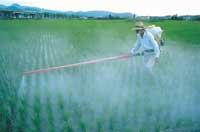The advantages of biofuels in doubt
2008/02/03 Álvarez Busca, Lucía - Elhuyar Zientziaren Komunikazioa

Biofuels are obtained from plants such as corn, sugar cane, rapeseed and palm. These plants are currently used for food. Therefore, to meet the needs of food and fuel, it should increase its production. This requires three elements: water, rural soil and fertilizers. In addition to these factors, there are many others that influence the environmental impact of biofuel production, but there are also disadvantages in these three elements.
The water problem
Different groups of researchers have calculated the amount of water needed for the development of biofuels and each of them has performed an analysis based on an objective. The first, ambitious: Replace half of the fossil fuels used for electricity and transport by 2050. Second, simpler: Multiply by 4 in 2030 the use of current biofuels to replace 7.5% of current oil.
In the first case it would take between 4,000 and 12,000 km3 more water per year. Bear in mind that the rivers of the planet carry only 14,000 km3/year. In the second case 180 km3 more would be enough per year. However, CO2 emissions do not decrease as much.
Rural land shortage
The number of farmland for biofuel raw materials has also been calculated. To do this, they have discarded built or cultivated land, deserts, forests, areas without vegetation, mountains, protected areas, hard climate zones and pastures. Thus, the planet can use between 250 and 300 million hectares for crops, that is, a plot of Argentine size.

Replacing 10% of global fuel consumption by 2030 with biofuels would account for 290 million hectares. However, those who have set the goal of quadrupling the amount of biofuels currently used, estimate that it would be enough with 30 million Ha. That is, 2.5 times more than is currently used.
In both cases it would be enough land that is free for cultivation, but it must be taken into account that by 2030 there will be 2-3 million more people to feed. This will require 200 million hectares and another 25 million hectares for the biofuel industries.
The sum result is net. In the first case it is not enough to develop biofuels that replace fossil fuel consumption. Not even a small part of future consumption. In the second it would be possible, but the replacement is much smaller.
Fertilizers and nitrogen

Although there is sufficient soil and water, fertilizer is necessary for plant cultivation, and problems have also been found in the use of fertilizers. These fertilizers contain nitrogen. A percentage of this nitrogen is transformed into nitrous oxide (NO2) and released into the atmosphere, affecting NO2 to Earth's warming, as well as CO2. Therefore, in this regard, it is not worth replacing fossil fuels with biofuels.
Although there are more optimistic or pessimistic forecasts, fossil fuels will ever end. Currently, experts believe that biofuels are the most appropriate and clean option, with fewer CO2 emissions and renewable raw materials. But the goals that can be achieved are very simple than previously thought. Is the dream of biofuels being dusted?
Published in 7k

Gai honi buruzko eduki gehiago
Elhuyarrek garatutako teknologia





